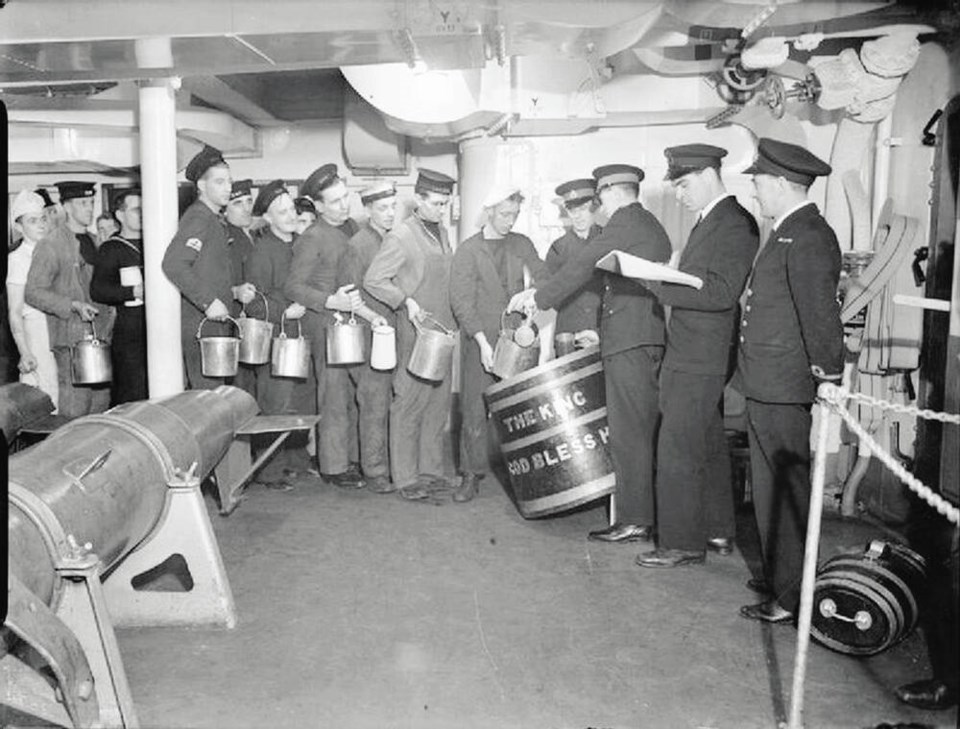A longstanding naval tradition came to an end five decades ago. On March 30, 1972, sailors aboard Canada’s naval vessels received their final “tots,” and a tradition much older than our navy itself ended.
It was a rum day.
Since the mid-17th century, as midday approached, the bosun’s pipe would call sailors serving aboard Royal Navy ships to “up spirits.” It was the call to grab their tot glasses and muster for their daily ration of booze.
The Canadian Navy adopted the practice, and many others, when it formed in 1910.
With what we know today about alcohol’s effect on performance, productivity, judgment and even health, it seems strange that hard liquor was for so long a part of daily life on board ship. But for much of history, water simply was not readily available or even safe to drink.
On long sea voyages, water supplies, stored in barrels and loaded at ports of call or wherever landfall was made, could turn rancid or run out. Beer may seem a better choice for daily rations when water isn’t available.
But even beer, the original rationed Royal Navy drink, spoiled easily at sea, particularly on voyages through the tropics. And in those days, beer often contained as much alcohol as wine.
However, in about 1655, the British wrested the island of Jamaica from Spanish control. Many ships took advantage of the resulting newly British supplies of rum to switch to providing rum to their sailors.
Rum had the advantage over beer and wine in that it didn’t spoil inside barrels. In addition, because the daily rum ration was only eight ounces (1/2 pint), compared to one gallon of beer or one pint of wine, less needed to be carried on voyages, freeing space for cargo.
That said, in the early years, different distilled liquors were issued on different ships, depending on where in the British empire they were stationed. Sailors near India got arrack. Those sailing the Atlantic might be issued brandy or gin instead.
But by the end of the wars with France in the early 1800s, rum became the official drink of the Royal Navy.
It was brought to England from the Caribbean, aged briefly, then shipped to where it was needed.
A few decades later, the daily ration was reduced to 2.5 ounces of rum — the amount those serving aboard Royal Canadian Navy vessels would later receive. The drink was cut with water and juice (making “grog”) or — later — other mixes.
It also had to be drunk on the spot, with no sipping or saving it for later to barter with other sailors.
Once they’d drunk their ration, the sailors returned to their stations.
In 1939, the Canadian government considered changing the daily ration to brandy for all of Canada’s active service forces, but Parliament rejected the proposal.
The navy also allowed sailors to opt for cash payments in lieu of the rum tot. In 1945, for example, the minister in charge of the Canadian navy disclosed that about 60 per cent of navy seamen were taking the extra five-cents-per-day pay instead.
When the Canadian navy abolished the daily ration in 1972, it was following in the steps of the Royal Navy, which had ended the practice in 1970.
By then, ships had become complex machines, with computers, electronics, sensitive instruments and critical life systems that needed sharp minds and clear wits to operate. Having crew who were mildly buzzed, three sheets to the wind or hung over was not in the interests of the safety of the crew overall, the vessel and its deployments, or the public.
In 2014, the Canadian Navy took further issue with sailors drinking at sea. Until then, sailors could consume alcohol while the vessel was at sea if they were not on duty in less than six hours. But in December that year, the navy implemented a partial ban on drinking at sea, prohibiting drinking at sea with the exception of special occasions.
At the time the rum ration was discontinued, it cost the Canadian government $363,000 a year (1972 dollars).
The Royal Australian Navy had ended its rum-tot tradition in 1921. The last navy to issue the daily rum ration, the Royal New Zealand Navy, abolished the practice in February 1990.
keiran_monique@rocketmail.com



